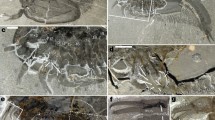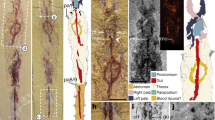Abstract
The morphology of the arthropod Sanctacaris uncata, from the Middle Cambrian Burgess Shale of Canada, is reinterpreted based on a restudy of previously described material. Although originally considered a chelicerate-like arthropod, these affinities were dismissed based primarily on interpretations of the anterior appendages and hypotheses which considered the megacheirans (‘great-appendage’ arthropods) as putative ancestors of chelicerates. The similarities between megacheirans and chelicerates appear to be overstated however, and this study instead reaffirms the identity of putative chelicerate feature in S. uncata and similar arthropods such as Sidneyia and Emeraldella, both also from the Middle Cambrian Burgess Shale. Newly interpreted features, including the presence of pediform exites, multi-partite trunk exopods, and a trunk differentiated into an anterior limb-bearing area and a differentiated posterior limbless abdomen, were coded into an extensive phylogenetic data set of fossil and recent arthropods. In all analyses, Sanctacaris resolved as the basal-most member of total-group Euchelicerata (the least inclusive group including horseshoe crabs and arachnids but not pycnogonids), thus making it the oldest chelicerate in the fossil record. The vicissicaudates (including Sidneyia, Emeraldella, aglaspidids, and cheloniellids—all of which have previously been allied to chelicerates) resolved as sister-taxon to crown-group Chelicerata. This topology indicates that many purported chelicerate features, such as lamellar gills, and a differentiated posterior abdomen evolved sequentially in the chelicerate stem-lineage.





Similar content being viewed by others
References
Bergström J, Hou X-G (2003) Arthropod origins. Bull Geosci 78:323–334
Bousfield EL (1995) A contribution to the natural classification of Lower and Middle Cambrian arthropods: food-gathering and feeding mechanism. Amphipacifica 2:3–34
Boxshall GA (2004) The evolution of arthropod limbs. Biol Rev 79:253–300
Boxshall GA (2013) Arthropod limbs and their development. In: Minelli A, Boxshall G, Frusco G (eds) Arthropod biology and evolution. Molecules, development, morphology, Springer, pp. 241–267
Briggs DEG, Collins D (1988) A Middle Cambrian chelicerate from Mount Stephen, British Columbia. Palaeontology 31:779–798
Briggs DEG, Collins D (1999) The arthropod Alalcomenaeus cambricus Simonetta, from the Middle Cambrian Burgess Shale of British Columbia. Palaeontology 42:953–977
Briggs DEG, Siveter DJ, Siveter DJ, Sutton MD, Garwood RJ, Legg DA (2012) A Silurian horseshoe crab illuminates the evolution of chelicerate limbs. Proc Natl Acad Sci U S A 109:15702–15705
Bruton DL (1981) The arthropod Sidneyia inexpectans, Middle Cambrian, Burgess Shale, British Columbia. Phil Trans R Soc Lond B 295:619–653
Bruton DL, Whittington HB (1983) Emeraldella and Leanchoilia, two arthropods from the Burgess Shale, middle Cambrian, British Columbia. Phil Trans R Soc Lond B 300:553–582
Budd G (2002) A palaeontological solution to the arthropod head problem. Nature 417:271–275
Chen J-Y, Waloszek D, Maas A (2004) A new ‘great-appendage arthropod’ from the Lower Cambrian of China and homology of chelicerate chelicerae and raptorial antero-ventral appendages. Lethaia 37:3–20
Collins D, Briggs DEG, Conway MS (1983) New Burgess Shale fossil sites reveal Middle Cambrian faunal complex. Science 22:163–167
Cotton TJ, Braddy SJ (2004) The phylogeny of arachnomorph arthropods and the origin of Chelicerata. Trans R Soc Edinb Earth Sci 94:169–193
Dewel RA, Dewel WC (1997) The place of tardigrades in arthropod evolution. In: Fortey RA, Thomas RH (eds) Arthropod relationships. Chapman & Hall, London, pp 109–123
Dunlop JA (2005) New ideas about the euchelicerate stem-lineage. In: Deltshev C, Stoev P (eds) European arachnology 2005, pp. 9–23. Acta Zool Bulg Suppl 1
Dunlop JA, Selden PA (1997) The early history and phylogeny of the chelicerates. In: Fortey RA, Thomas RH (eds) Arthropod relationships. Chapman & Hall, London, pp 221–238
Dunlop JA, Anderson LI, Braddy SJ (2004) A redescription of Chasmataspis laurencii Caster & Brooks, 1956 (Chelicerata, Chasmataspidida) from the Middle Ordovician of Tennessee, USA, with remarks on chasmataspid phylogeny. Trans R Soc Edinb Earth Sci 94:207–225
Edgecombe GD, García-Bellido DC, Paterson JR (2011) A new leanchoiliid megacheiran arthropod from the lower Cambrian Emu Bay Shale, South Australia. Acta Palaeontol Pol 56:385–400
Eldredge N (1974) Revision of the Synziphosura (Chelicerata, Merostomata), with remarks on merostome phylogeny. Am Mus Novit 2543:1–41
Fletcher TP, Collins DH (1998) The Middle Cambrian Burgess Shale and its relationship to the Stephen formation in the Southern Canadian Rocky Mountains. Can J Earth Sci 17:400–418
Fletcher TP, Collins DH (2003) The Burgess Shale and associated Cambrian formations west of the Fossil Gully Fault Zone on Mount Stephen, British Columbia. Can J Earth Sci 40:1823–1838
Goloboff PA (1999) Analyzing large data sets in reasonable times: solutions for composite optima. Cladistics 15:415–428
Goloboff PA, Carpenter JM, Salvador Arias J, Rafael Miranda Esquivel D (2008a) Weighting against homoplasy improves phylogenetic analysis of morphological data sets. Cladistics 24:758–773
Goloboff PA, Farris JS, Nixon KC (2008b) TNT, a free program for phylogenetic analysis. Cladistics 24:774–786
Haug JT, Waloszek D, Maas A, Liu Y, Haug C (2012) Functional morphology, ontogeny and evolution of mantis shrimp-like predators in the Cambrian. Palaeontology 55:369–399
Hesselbo SP (1992) Aglaspidida (Arthropoda) from the Upper Cambrian of Wisconsin. J Paleontol 66:885–923
Hou X-G, Bergström J (1997) Arthropods of the lower Cambrian Chengjiang fauna, southwest China. Fossils Strata 45:1–116
Lamsdell JC (2013) Revised systematics of the Palaeozoic ‘horseshoe crabs’ and the myth of monophyletic Xiphosura. Zool J Linn Soc 167:1–27
Lauterbach K-E (1980) Schlüsselereignisse in der Evolution des Grundplans der Arachnata (Arthropoda). Abh Verh Naturwiss Vereins Hamburg 26:293–320
Lee MSY, Soubrier J, Edgecombe GD (2013) Rates of phenotypic and genomic evolution during the Cambrian explosion. Curr Biol 23:1–7
Legg DA (2013) Multi-segmented arthropods from the middle Cambrian of British Columbia (Canada). J Paleontol 87:493–501
Legg DA, Caron J-B (2014) New Middle Cambrian bivalved arthropods from the Burgess Shale (British Columbia, Canada). Palaeontology 57:691–711
Legg DA, Sutton MD, Edgecombe GD, Caron J-B (2012) Cambrian bivalved arthropod reveals origin of arthrodization. Proc R Soc B 279:4699–4704
Legg DA, Sutton MD, Edgecombe GD (2013) Arthropod fossil data increase congruence of morphological and molecular phylogenies. Nat Commun 4:2485
Ma X, Hou X-G, Edgecombe GD, Strausfeld NJ (2012) Complex brain and optic lobes in an early Cambrian arthropod. Nature 490:258–261
Nixon KC (1999) The parsimony ratchet, a new method for rapid parsimony analysis. Cladistics 15:407–414
Orr PJ, Siveter DJ, Briggs DEG, Siveter DJ, Sutton MD (2000) A new arthropod from the Silurian Konservat-Lagerstätte of Herefordshire, England. Proc R Soc Lond B 267:1497–1504
Ortega-Hernández J, Legg DA, Braddy SJ (2013) The phylogeny of aglaspidid arthropods and the internal relationships within Artiopoda. Cladistics 29:15–45
Reisinger PWM, Tutter I, Welsch U (1991) Fine structure of the gills of the horseshoe crabs Limulus Polyphemus and Tachypleus tridentatus and of the book lungs of the spider Eurypelma californicum. Zool Jahrb Abt Anat Ontog 121:331–357
Rota-Stabelli O, Daley AC, Pisani D (2013) Molecular timetrees reveal a Cambrian colonization of land and a new scenario for ecdysozoan evolution. Curr Biol 23:392–398
Scholtz G, Edgecombe GD (2005) Head, Hox and the phylogenetic position of trilobites. In: Koenemann S, Jenner R (eds) Crustacea and arthropod relationships. Taylor & Francis, Oxford, pp 139–165
Scholtz G, Edgecombe GD (2006) The evolution of arthropod heads: reconciling morphological, developmental and palaeontological evidence. Dev Genes Evol 216:395–415
Sharma PP, Schwager EE, Giribet G, Jockusch EL, Extavour CG (2013) Distal-less and dashshund pattern both plesiomorphic and apomorphic structures in chelicerates: RNA interference in the harvestman Phalangium opilio (Opiliones). Evol Dev 15:228–242
Siveter DJ, Briggs DEG, Siveter DJ, Sutton MD, Legg DA, Joomun S (2014) A Silurian short-great-appendage arthropod. Proc R Soc Lond B 281 (in press)
Stein M (2013) Cephalic and appendage morphology of the Cambrian arthropod Sidneyia inexpectans. Zool Anz 253:164–178
Stein M, Selden PA (2012) A restudy of the Burgess Shale (Cambrian) arthropod Emeraldella brocki and reassessment of its affinities. J Syst Palaeontol 10:361–383
Størmer L (1944) On the relationships and phylogeny of fossil and recent Arachnomorpha. Skrift Norske Vidensk Acad I Oslo 5:1–158
Strausfeld NJ (2012) Arthropod brains: evolution, functional elegance, and structural significance. Harvard University Press, Cambridge, p 650
Sutton MD, Briggs DEG, Siveter DJ, Siveter DJ, Orr PJ (2002) The arthropod Offacolus kingi (Chelicerata) from the Silurian of Herefordshire, England: computer based morphological reconstructions and phylogenetic affinities. Proc R Soc Lond B 269:1195–1203
Tanaka G, Hou X-G, Ma X, Edgecombe GD, Strausfeld NJ (2013) Chelicerate neural ground pattern in a Cambrian great appendage arthropod. Nature 502:364–367
Van Roy P, Orr PJ, Botting JP, Muir LA, Vinther J, Lefebvre B, el Hariri K, Briggs DEG (2010) Ordovician faunas of Burgess Shale type. Nature 465:215–218
Waloszek D, Dunlop JA (2002) A larval sea spider (Arthropoda: Pycnogonida) from the Upper Cambrian ‘Orsten’ of Sweden, and the phylogenetic position of pycnogonids. Palaeontology 45:421–446
Weygoldt P (1986) Arthropod interrelationships—the phylogenetic-systematic approach. J Zool Syst Evol Res 24:19–35
Wills MA, Briggs DEG, Fortey RA, Wilkinson M (1995) The significance of fossils in understanding arthropod evolution. Verh Dtsch Zool Ges 88:203–215
Wills MA, Briggs DEG, Fortey RA, Wilkinson M, Sneath PHA (1998) An arthropod phylogeny based on fossil and recent taxa. In: Edgecombe GD (ed) Arthropod fossils and phylogeny. Columbia University Press, New York, pp 33–105
Yang J, Ortega-Hernández J, Butterfield NJ, Zhang X-G (2013) Specialized appendages in fuxianhuiids and the head organization of early arthropods. Nature 494:468–471
Zhang Z-Q (2011) Phylum Arthropoda von Siebold 1848. Zootaxa 3148:99–103
Zhang X-L, Shu D-G (2005) A new arthropod from the Chengjiang Lagerstätte, Early Cambrian, southern China. Alcheringa 29:185–194
Acknowledgments
Thanks go to J.-B. Caron and P. Fenton, both at the Royal Ontario Museum, Toronto (ROM), for access to material in their care. Thanks also to Nicola Woods (ROM) for providing additional photographs of Sanctacaris uncata, J. Lamsdell (Yale Peabody Museum) for providing additional photos of Sidneyia inexpectans, G. Edgecombe (Natural History Museum, London) and J. Dunlop (Museum für Naturkunde, Berlin) for the comments on an earlier version of this manuscript and X. Ma (NHM, London) and J. Ortega-Hernández for the critical discussion.
Author information
Authors and Affiliations
Corresponding author
Additional information
Communicated by: Sven Thatje
Electronic supplementary material
Below is the link to the electronic supplementary material.
ESM 1
(DOCX 88 kb)
Supplementary figure 1
(DOCX 903 kb)
Rights and permissions
About this article
Cite this article
Legg, D.A. Sanctacaris uncata: the oldest chelicerate (Arthropoda). Naturwissenschaften 101, 1065–1073 (2014). https://doi.org/10.1007/s00114-014-1245-4
Received:
Revised:
Accepted:
Published:
Issue Date:
DOI: https://doi.org/10.1007/s00114-014-1245-4




